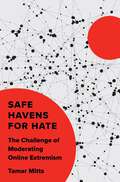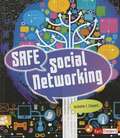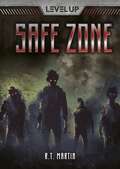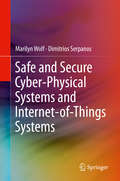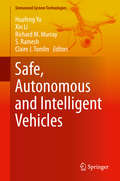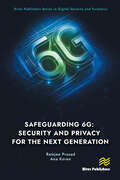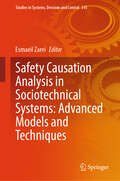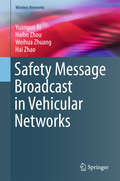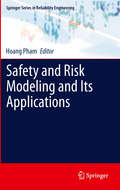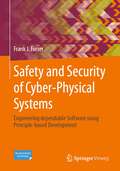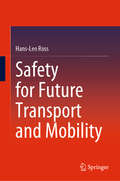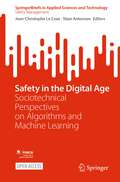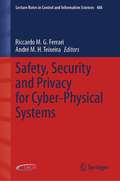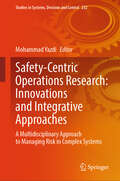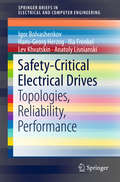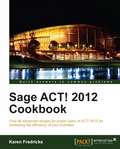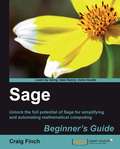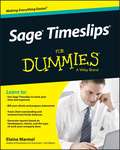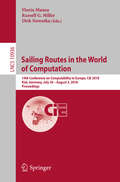- Table View
- List View
Safe Havens for Hate: The Challenge of Moderating Online Extremism
by Tamar MittsWhy efforts to moderate harmful content on social media fail to stop extremistsContent moderation on social media has become one of the most daunting challenges of our time. Nowhere is the need for action more urgent than in the fight against terrorism and extremism. Yet despite mass content takedowns, account suspensions, and mounting pressure on technology companies to do more, hate thrives online. Safe Havens for Hate looks at how content moderation shapes the tactics of harmful content producers on a wide range of social media platforms.Drawing on a wealth of original data on more than a hundred militant and hate organizations around the world, Tamar Mitts shows how differing moderation standards across platforms create safe havens that allow these actors to organize, launch campaigns, and mobilize supporters. She reveals how the structure of the information environment shapes the cross-platform activity of extremist organizations and movements such as the Islamic State, the Proud Boys, the Oath Keepers, and QAnon, and highlights the need to consider the online ecosystem, not just individual platforms, when developing strategies to combat extremism.Taking readers to the frontlines of the digital battleground where dangerous organizations operate, Safe Havens for Hate sheds critical light on how governments and technology companies grapple with the tension between censorship and free speech when faced with violence, hate, and extremism.
Safe Social Networking
by Frank W. Baker Heather E. SchwartzDescribes safe social networking usage and ways to avoid dangerous situations, such as identity theft, cyberbullying, or predators.
Safe Trajectory Planning for Maritime Surface Ships (Springer Series on Naval Architecture, Marine Engineering, Shipbuilding and Shipping #13)
by Agnieszka LazarowskaThis book offers a comprehensive review of collision avoidance techniques and safe trajectory planning for manned and unmanned ships, together with extensive information on how to develop and implement algorithms for applications in real-world settings. It describes the most relevant decision-support systems and guidance systems used in the control of marine craft, giving a special emphasis to autonomous vehicles, but also covering manned ones. Thanks to its good balance of theory and practice, and the inclusion of basic explanations of all essential concepts, this book fills an important gap in the literature of marine navigation, providing not only researchers and practitioners with a timely reference guide to safe trajectory planning, but also supporting students and newcomers to the field.
Safe Zone (Level Up)
by R. T. MartinNo_Idea has actually no idea how he wound up in the middle of a zombie apocalypse. It's not until he meets another player, named N3V3RDIE, that he learns he's been selected to test a virtual reality video game. And if they don't win the game, they'll be stuck inside the virtual world forever. Will No_Idea figure out the gameplay and make it to the game's safe zone in time, or will he end up trapped in a world filled with virtual zombies?
Safe and Secure Cyber-Physical Systems and Internet-of-Things Systems
by Marilyn Wolf Dimitrios SerpanosThis book provides the first comprehensive view of safe and secure CPS and IoT systems. The authors address in a unified manner both safety (physical safety of operating equipment and devices) and computer security (correct and sound information), which are traditionally separate topics, practiced by very different people. Offers readers a unified view of safety and security, from basic concepts through research challenges;Provides a detailed comparison of safety and security methodologies;Describes a comprehensive threat model including attacks, design errors, and faults;Identifies important commonalities and differences in safety and security engineering.
Safe, Autonomous and Intelligent Vehicles (Unmanned System Technologies)
by Xin Li Richard M. Murray Huafeng Yu S. Ramesh Claire J. TomlinThis book covers the start-of-the-art research and development for the emerging area of autonomous and intelligent systems. In particular, the authors emphasize design and validation methodologies to address the grand challenges related to safety. This book offers a holistic view of a broad range of technical aspects (including perception, localization and navigation, motion control, etc.) and application domains (including automobile, aerospace, etc.), presents major challenges and discusses possible solutions.
Safe, Secure, Ethical, Responsible Technologies and Emerging Applications: First EAI International Conference, SAFER-TEA 2023, Yaoundé, Cameroon, October 25-27, 2023, Proceedings (Lecture Notes of the Institute for Computer Sciences, Social Informatics and Telecommunications Engineering #566)
by Franklin Tchakounte Marcellin Atemkeng Rajeswari Pillai RajagopalanThis book constitutes the refereed proceedings of the First EAI International Conference on Safe, Secure, Ethical, Responsible Technologies and Emerging Applications, SAFER-TEA 2023, held in Yaoundé, Cameroon, during October 25-27, 2023. The 24 full papers were carefully reviewed and selected from 75 submissions. They were organized in topical sections as follows: Regulations and Ethics of Artificial Intelligence, Resource-constrained Networks and Cybersecurity, Emerging Artificial Intelligence Applications, Reviews.
Safeguarding 6G: Security and Privacy for the Next Generation (River Publishers Series in Digital Security and Forensics)
by Ramjee Prasad Ana KorenThis book provides a comprehensive overview of security and privacy challenges in 6G networks, addressing the urgent need for advanced security frameworks as the next generation of wireless technology emerges. The rapid advancements in quantum computing, AI, and IoT are transforming the digital landscape, introducing both unprecedented opportunities and significant security threats. From AI-driven cyberattacks to the vulnerabilities of IoT devices, this book explores cutting-edge technologies such as quantum key distribution (QKD), post-quantum cryptography, and AI-enabled security systems.Designed for professionals and researchers, this resource outlines real-world applications of 6G security techniques, offering practical insights into protecting critical infrastructures, autonomous vehicles, smart cities, and more. By emphasizing a proactive approach to cybersecurity and fostering collaboration across industries, academia, and policymakers, the book lays out a roadmap for ensuring the resilience and trustworthiness of 6G networks in the future.
Safeguarding the Future: Security and Privacy by Design for AI, Metaverse, Blockchain, and Beyond (Security, Audit and Leadership Series)
by Alan TangIn the ever-evolving landscape of technology, emerging innovations like artificial intelligence (AI), blockchain, quantum computing, brain–computer interfaces (BCIs), and the Metaverse are transforming industries at an unprecedented rate. However, with these advancements come significant challenges, particularly in the realms of security and privacy. Safeguarding the Future: Security and Privacy by Design for AI, Metaverse, Blockchain, and Beyond by Dr. Alan Tang offers a comprehensive guide to navigating these challenges, providing a holistic framework to secure and protect the privacy of these cutting-edge technologies.What sets this book apart is its unique blend of technical depth and practical application. Dr. Tang leverages his extensive experience in privacy and security to deliver actionable insights that are crucial for organizations looking to stay ahead in this rapidly changing digital era. From aligning business strategies with security and privacy goals to implementing unified frameworks across multiple technologies, this book is an essential resource for executives, security professionals, and anyone involved in the deployment of emerging technologies.Key Features: In-Depth Analysis: Detailed exploration of the security and privacy risks associated with AI, blockchain, quantum computing, BCI, and other emerging technologies Unified Frameworks: A comprehensive, step-by- step guide to creating and operationalizing a unified security and privacy framework adaptable to various technologies Regulatory Alignment: Insights into aligning security and privacy practices with global regulations such as GDPR, CCPA, and ISO standards Case Studies and Real-World Examples: Practical case studies and examples that illustrate how to apply the concepts discussed in real-world scenarios Ethical Considerations: Examination of ethical issues surrounding the deployment of these technologies, with recommendations for addressing them proactively Future-Proofing Strategies: Guidance on preparing for future advancements and ensuring long-term compliance and security Whether you are a chief technology officer, chief privacy officer, data protection officer, or a security professional, this book equips you with the knowledge and tools needed to protect your organization’s data and ensure the secure deployment of emerging technologies. By adopting the principles outlined in this book, you can not only harness the full potential of these innovations but also safeguard the privacy and security of your organization and its stakeholders.
Safety Causation Analysis in Sociotechnical Systems: Advanced Models and Techniques (Studies in Systems, Decision and Control #541)
by Esmaeil ZareiThis book provides a comprehensive view on theories, models, and techniques used to investigate and analyze incidents and safety causalities occurring in sociotechnical systems. Consisted of intricately interconnected components, sociotechnical systems are always prone to incidents. These incidents can ensue with adverse effects on employees and the public, the environment, and company's properties and reputation. Sometimes, a single incident has the potential to terminate the operation of a business forever. As incidents are multi-factorial and not easy to comprehend, they should be investigated systematically in a structured way so as to find their root causes and prevent them from recurring. Consequently, there have been developed many theories, models, and techniques aimed at accomplishing this goal. However, each approach has its own upsides and downsides, and there is no universal one applicable to all cases. Therefore, researchers and practitioners may sometimes find it difficult to select the most appropriate approach for the given case. After introducing theories, models, and techniques pertaining to incident investigation and safety causalities modeling, this book explains each one in details and discusses their pros and cons. The book aims to provide the audience with a step-by-step guidance for performing incident investigation and analysis. At the end of each chapter an example is analyzed by the introduced tool. Finally, the book offers criteria based on which an incident analysis technique can be selected.
Safety Message Broadcast in Vehicular Networks
by Weihua Zhuang Haibo Zhou Yuanguo Bi Hai ZhaoThis book presents the current research on safety message dissemination in vehicular networks, covering medium access control and relay selection for multi-hop safety message broadcast. Along with an overall overview of the architecture, characteristics, and applications of vehicular networks, the authors discuss the challenging issues in the research on performance improvement for safety applications, and provide a comprehensive review of the research literature. A cross layer broadcast protocol is included to support efficient safety message broadcast by jointly considering geographical location, physical-layer channel condition, and moving velocity of vehicles in the highway scenario. To further support multi-hop safety message broadcast in a complex road layout, the authors propose an urban multi-hop broadcast protocol that utilizes a novel forwarding node selection scheme. Additionally, a busy tone based medium access control scheme is designed to provide strict priority to safety applications in vehicle-to-infrastructure communications. This book offers useful insights into protocol design and inspires a new line of thinking in performance improvements for safety applications in vehicular networks. It is a valuable resource for professionals, researchers, or advanced-level students working in vehicular networks or quality of service.
Safety and Risk Modeling and Its Applications
by Hoang PhamSafety and Risk Modeling presents the latest theories and methods of safety and risk with an emphasis on safety and risk in modeling. It covers applications in several areas including transportations and security risk assessments, as well as applications related to current topics in safety and risk. Safety and Risk Modeling is a valuable resource for understanding the latest developments in both qualitative and quantitative methods of safety and risk analysis and their applications in operating environments. Each chapter has been written by active researchers or experienced practitioners to bridge the gap between theory and practice and to trigger new research challenges in safety and risk. Topics include: safety engineering, system maintenance, safety in design, failure analysis, and risk concept and modelling. Postgraduate students, researchers, and practitioners in many fields of engineering, operations research, management, and statistics will find Safety and Risk Modeling a state-of-the-art survey of reliability and quality in design and practice.
Safety and Security of Cyber-Physical Systems: Engineering dependable Software using Principle-based Development
by Frank J. FurrerCyber-physical systems (CPSs) consist of software-controlled computing devices communicating with each other and interacting with the physical world through sensors and actuators.Because most of the functionality of a CPS is implemented in software, the software is of crucial importance for the safety and security of the CPS. This book presents principle-based engineering for the development and operation of dependable software.The knowledge in this book addresses organizations that want to strengthen their methodologies to build safe and secure software for mission-critical cyber-physical systems.The book:• Presents a successful strategy for the management of vulnerabilities, threats, and failures in mission-critical cyber-physical systems;• Offers deep practical insight into principle-based software development (62 principles are introduced and cataloged into five categories: Business & organization, general principles, safety, security, and risk management principles);• Provides direct guidance on architecting and operating dependable cyber-physical systems for software managers and architects.
Safety for Future Transport and Mobility
by Hans-Leo RossThe book provides background information about technical solutions, processes and methodology to develop future automated mobility solutions. Beginning from the legal requirements as the minimum tolerable risk level of the society, the book provides state-of-the-art risk-management methodologies. The system engineering approach based on todays engineering best practices enhanced by principles derived from cybernetics. The approach derived from the typical behaviour of a human driver in public road traffic to a cybernetical based system engineering approach. Beyond the system engineering approach, a common behaviour model for the operational domain will show aspects how to extend the system engineering model with principles of cybernetics. The role and the human factors of road traffic participants and drivers of motor vehicles are identified and several viewpoints for different observers show how such mixed traffic scenarios could be assessed and optimised. The influence of the changing mobility demands of the society and the resulting changes to the origination of producer, owner, driver and supplier show aspects for future liability and risk share option for new supply chains. Examples from various industries provide some well-proven engineering principles how to adapt those for the future mobility for the benefit of the users. The aim of the book is to raise awareness that the safety provided by a product, a means of transport or a system up to an entire traffic system depends on the capabilities of the various actors. In addition to the driver and passengers, there are also other road users, maintenance personnel and service providers, who must have certain abilities to act safely in traffic. These are also the capabilities of the organisation, not only the organisation that develops or brings the product to market, but also the organisation that is responsible for the operation and the whole lifecycle of the products. The book is for people who want to get involved in the mobility of the future. People, that have ideas to become a player who want to help shape the future mobility of society and who want to bring responsible solutions for users into the market.
Safety in the Digital Age: Sociotechnical Perspectives on Algorithms and Machine Learning (SpringerBriefs in Applied Sciences and Technology)
by Jean-Christophe Le Coze Stian AntonsenThis open access book gathers authors from a wide range of social-scientific and engineering disciplines to review challenges from their respective fields that arise from the processes of social and technological transformation taking place worldwide. The result is a much-needed collection of knowledge about the integration of social, organizational and technical challenges that need to be tackled to uphold safety in the digital age.The contributors whose work features in this book help their readers to navigate the massive increase in the capability to generate and use data in developing algorithms intended for automation of work, machine learning and next-generation artificial intelligence and the blockchain technology already in such extensive use in real-world organizations.This book deals with such issues as:· How can high-risk and safety-critical systems be affected by these developments, in terms of their activities, their organization, management and regulation?· What are the sociotechnical challenges of the proliferation of big data, algorithmic influence and cyber-security challenges in health care, transport, energy production/distribution and production of goods?Understanding the ways these systems operate in the rapidly changing digital context has become a core issue for academic researchers and other experts in safety science, security and critical-infrastructure protection. The research presented here offers a lens through which the reader can grasp the way such systems evolve and the implications for safety—an increasingly multidisciplinary challenge that this book does not shrink from addressing.
Safety of Computer Architectures
by Jean-Louis BoulangerIt is currently quite easy for students or designers/engineers to find very general books on the various aspects of safety, reliability and dependability of computer system architectures, and partial treatments of the elements that comprise an effective system architecture. It is not so easy to find a single source reference for all these aspects of system design. However, the purpose of this book is to present, in a single volume, a full description of all the constraints (including legal contexts around performance, reliability norms, etc.) and examples of architectures from various fields of application, including: railways, aeronautics, space, automobile and industrial automation.The content of the book is drawn from the experience of numerous people who are deeply immersed in the design and delivery (from conception to test and validation), safety (analysis of safety: FMEA, HA, etc.) and evaluation of critical systems. The involvement of real world industrial applications is handled in such as a way as to avoid problems of confidentiality, and thus allows for the inclusion of new, useful information (photos, architecture plans/schematics, real examples).
Safety, Security and Privacy for Cyber-Physical Systems (Lecture Notes in Control and Information Sciences #486)
by Riccardo M. G. Ferrari André M. H. TeixeiraThis book presents an in-depth overview of recent work related to the safety, security, and privacy of cyber-physical systems (CPSs). It brings together contributions from leading researchers in networked control systems and closely related fields to discuss overarching aspects of safety, security, and privacy; characterization of attacks; and solutions to detecting and mitigating such attacks. The book begins by providing an insightful taxonomy of problems, challenges and techniques related to safety, security, and privacy for CPSs. It then moves through a thorough discussion of various control-based solutions to these challenges, including cooperative fault-tolerant and resilient control and estimation, detection of attacks and security metrics, watermarking and encrypted control, privacy and a novel defense approach based on deception. The book concludes by discussing risk management and cyber-insurance challenges in CPSs, and by presenting the future outlook for this area of research as a whole. Its wide-ranging collection of varied works in the emerging fields of security and privacy in networked control systems makes this book a benefit to both academic researchers and advanced practitioners interested in implementing diverse applications in the fields of IoT, cooperative autonomous vehicles and the smart cities of the future.
Safety-Centric Operations Research: A Multidisciplinary Approach to Managing Risk in Complex Systems (Studies in Systems, Decision and Control #232)
by Mohammad YazdiThis book offers a pioneering exploration into the integration of safety considerations with operations research, providing a vital toolkit for enhancing decision-making processes in hazardous industries. It delivers comprehensive insights and innovative methodologies to foster safety-centric planning and operations across various sectors. As the complexities of modern industries increase, so does the potential for operational risks. This book addresses this challenge by merging rigorous safety analysis with the quantitative sophistication of operations research. This book aims to create safer working environments and more resilient operational frameworks. The book is divided into several key sections, each focusing on different aspects of operations research applied to safety. Initial chapters lay a theoretical foundation, discussing mathematical models and statistical methods that prioritize safety. Subsequent sections delve into specific applications within supply chain management, transportation logistics, and production planning, illustrating how these methods can be practically applied to reduce risks and enhance operational safety. Advanced topics covered include the application of machine learning and artificial intelligence to predict and mitigate potential hazards and the use of simulation techniques to model and manage operational risks. Real-world case studies are presented to show the practical implementation of these theories in industries such as manufacturing, health care, and energy, providing readers with actionable insights and proven strategies. Additionally, the book examines the cultural and behavioral aspects of safety in operations, emphasizing the importance of building a robust safety culture and integrating human factors into safety planning. Ethical and regulatory dimensions are also explored to guide practitioners in navigating the complex legal landscapes that govern safety in various industries. This book is an essential resource for students, researchers, and professionals in operations research and management, especially those involved in planning and executing operations in safety-critical sectors. It is particularly relevant for those who aim to blend technical proficiency with practical safety solutions to solve real-world challenges in operations&’ management.
Safety-Critical Electrical Drives: Topologies, Reliability, Performance (SpringerBriefs in Electrical and Computer Engineering)
by Ilia Frenkel Anatoly Lisnianski Igor Bolvashenkov Hans-Georg Herzog Lev KhvatskinThis book focuses on one of the most important aspects of electrical propulsion systems – the creation of highly reliable safety-critical traction electrical drives. It discusses the methods and models for analysis and optimization of reliability and fault tolerance indices, based on which, it proposes and assesses methods for improving the availability, fault tolerance and performance of traction electric drives.
Sage ACT! 2011 Dashboard and Report Cookbook
by Karen Fredricks Roy LaudenslagerThis is a cookbook of easy-to-follow recipes about ACT! 2011 dashboard and report practices. If you are an ACT! end user who wants to learn about the existing reports and dashboards available in ACT! 2009, 2010, and 2011, then this book is for you. If you are an ACT! administrator who wants to make changes to ACT!'s dashboard and reporting features or a sales manager who needs to measure the effectiveness of his sales force, you will also find this book helpful. New CRM users will learn how to measure the success of their database. Prior knowledge of ACT! is not essential; however, you'll find it helpful to have good working knowledge of how to add data to ACT!, or to work with an ACT! database that has already been populated with data.
Sage ACT! 2012 Cookbook
by Karen FredricksThis is an advanced cookbook of easy-to-follow recipes about ACT! 2012 designed to transform you into an ACT! Power User. If you are an ACT! end user who wants to learn about the advanced functionality of ACT! 2012, then this book is for you. It will also be useful if you are a 2009,2010 or 2011 user, as many advanced features originate from these ACT! versions. If you are an ACT! administrator who needs to administer an ACT! database or understand Outlook integration, you will also find this book helpful. No prior ACT! knowledge is necessarily required; however, you'll find it helpful to have good working knowledge of how to add data into ACT!, or to work with an ACT! database that has already been populated with data.
Sage Beginner's Guide
by Craig FinchThis is a beginner's guide with clear step-by-step instructions, explanations, and advice. Each concept is illustrated with a complete example that you can use as a starting point for your own work. If you are an engineer, scientist, mathematician, or student, this book is for you. To get the most from Sage by using the Python programming language, we'll give you the basics of the language to get you started. For this, it will be helpful if you have some experience with basic programming concepts.
Sage Timeslips For Dummies
by Elaine MarmelLet Sage Timeslips For Dummies show you how to turn your time into moneyIf you run a business that bills for its time, it's time you looked into Sage Timeslips and all it can do for you. This practical and friendly guide will help you get to know the Timeslips interface, set up templates for your business, prepare bills and statements, generate reports, track payments, and manage your billable hours across multiple clients. You'll also get the scoop on utilizing a variety of billing scenarios commonly used by attorneys, consultants, accountants, architects, and other service professionals, including hourly, contingency, flat fee, percentage of completion, interim billing, progress billing, and more. Covers time-tracking basics and billing best practices for your specific business needsDetails how to set up Timeslips, account for hours, customize statements, prepare and send bills, reconcile payments, manage client databases, and keep your data safe and secureExplains how to integrate Sage Timeslips with QuickBooks and Peachtree accounting software as well as Microsoft Office productivity solutions like Outlook and Excel to help better manage and analyze your overall businessFrom sole practitioners running a small business to larger service firms with multiple timekeepers on a project, Sage Timeslips For Dummies is the key to tracking your time and increasing your profitability.
Sailing Routes in the World of Computation: 14th Conference on Computability in Europe, CiE 2018, Kiel, Germany, July 30 – August 3, 2018, Proceedings (Lecture Notes in Computer Science #10936)
by Florin Manea Dirk Nowotka Russell G. MillerThis book constitutes the refereed proceedings of the 14th Conference on Computability in Europe, CiE 2018, held in Kiel, Germany, in July/ August 2017.The 26 revised full papers were carefully reviewed and selected from 55 submissions. In addition, this volume includes 15 invited papers. The conference CiE 2018 has six special sessions, namely: Approximation and optimization, Bioinformatics and bio-inspired computing, computing with imperfect information, continuous computation, history and philosophy of computing (celebrating the 80th birthday of Martin Davis), and SAT-solving.
Sailing Safe in Cyberspace
by Anjali KaushikSailing Safe in Cyberspace is an excellent resource on safe computing. It gives in-depth exposure to the various ways in which security of information might be compromised, how cybercrime markets work and measures that can be taken to ensure safety at individual and organizational levels. Cyber security is not just a technical subject that can be resolved like any other IT-related problem--it is a 'risk' that can be mitigated by creating awareness and getting the right combination of technology and practices based on careful analysis. This book combines insights on cybersecurity from academic research, media reports, vendor reports, practical consultation and research experience. The first section of the book discusses motivation and types of cybercrimes that can take place. The second lists the major types of threats that users might encounter. The third discusses the impact, trend and role of the government in combating cybercrime. The fourth section of the book tells the readers about ways to protect themselves and secure their data/information stored in computers and the cyberspace. It concludes by offering suggestions for building a secure cyber environment.
